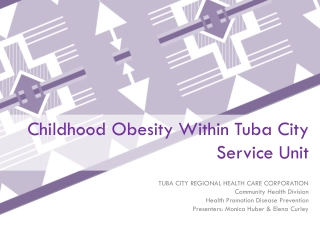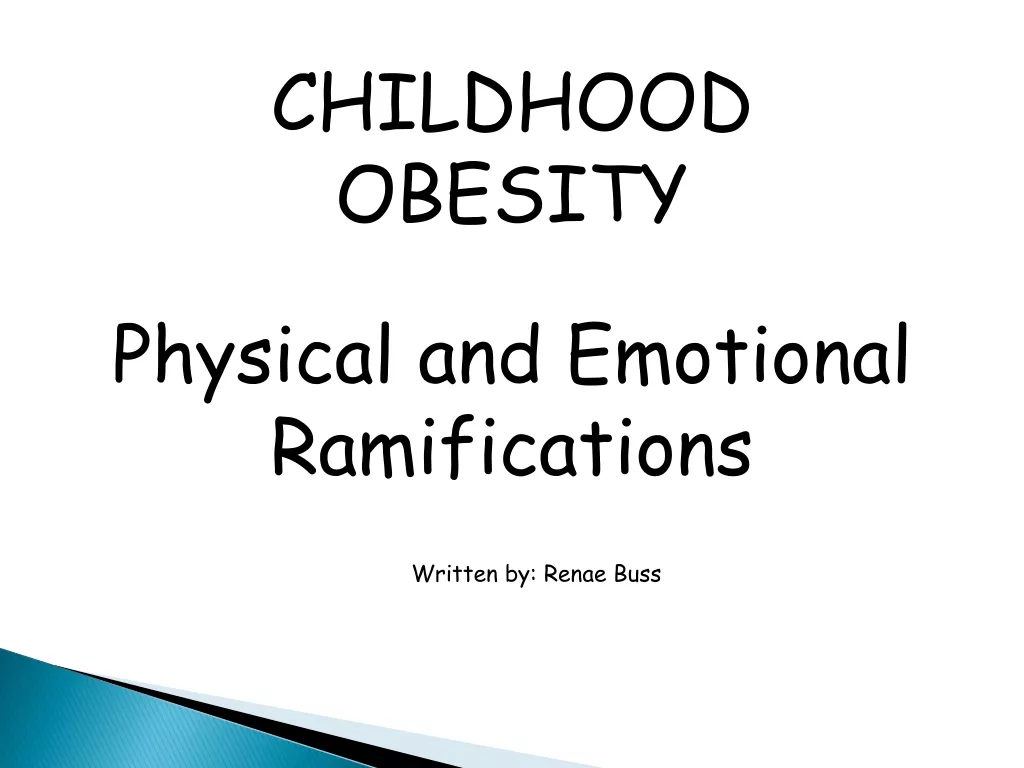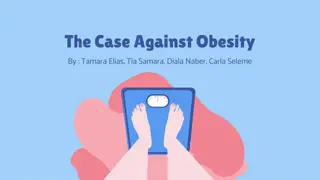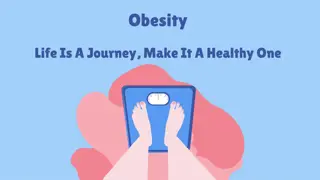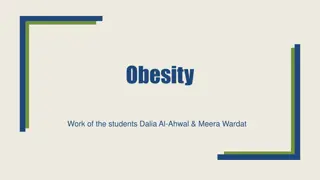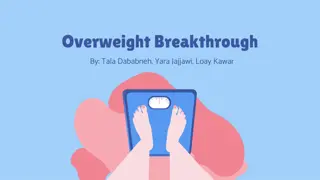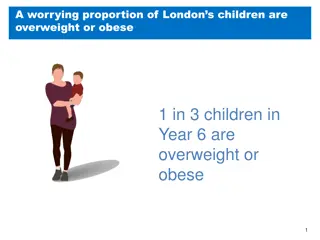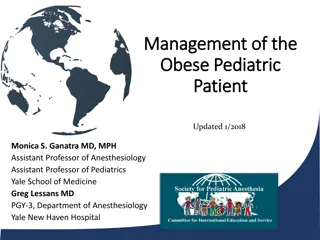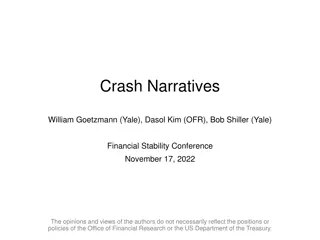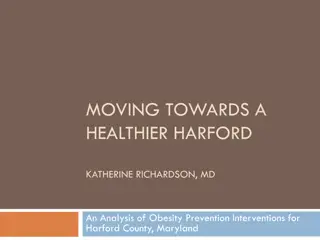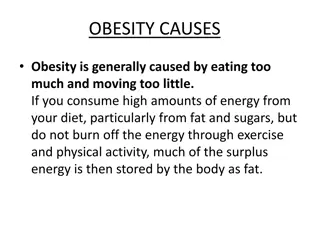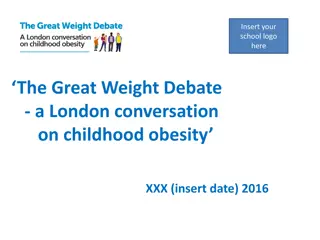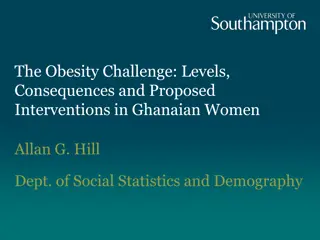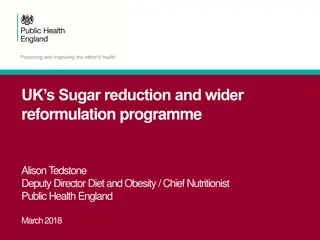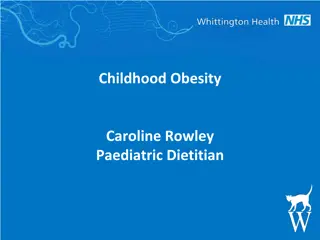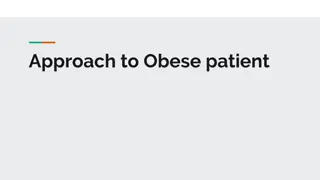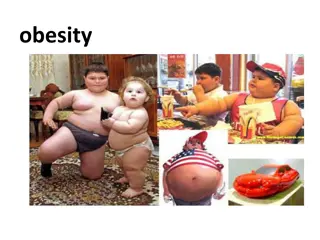Childhood Obesity Prevention Narratives Study
Feedback was obtained on childhood obesity prevention narratives from Mexican American mothers of children aged 3-4 in a study conducted by researchers at the University of South Carolina. The study involved face-to-face interviews and exposure to different narratives, aiming to address children's consumption of sugary beverages.
Download Presentation

Please find below an Image/Link to download the presentation.
The content on the website is provided AS IS for your information and personal use only. It may not be sold, licensed, or shared on other websites without obtaining consent from the author.If you encounter any issues during the download, it is possible that the publisher has removed the file from their server.
You are allowed to download the files provided on this website for personal or commercial use, subject to the condition that they are used lawfully. All files are the property of their respective owners.
The content on the website is provided AS IS for your information and personal use only. It may not be sold, licensed, or shared on other websites without obtaining consent from the author.
E N D
Presentation Transcript
RACHEL E. DAVIS, PH.D., SUZANNECOLE, PH.D., SHANNON MCKENNEY, M.P.H., LIGIA REYES, M.P.H., KARENE. PETERSON, SC.D. UNIVERSITY OFSOUTHCAROLINA NUTRITIONSYMPOSIUM, MARCH 21, 2014
(A)nycohesive and coherent story with an identifiable beginning, middle, and end that provides information about scene, characters, and conflict; raises unanswered questions or unresolved conflict; and provides resolution. 1 1 Hinyard, L.J., & Kreuter, M.W. (2007) Using narrative communication as a tool for health behavior change: A conceptual, theoretical, and empirical overview. Health Education & Behavior, 34(5): 977-792.
Study goal: To obtain feedback on childhood obesity prevention narratives Participants: Mexican American mothers of children ages 3-4 (n = 40) Special Supplemental Nutrition Program for Women, Infants, and Children (WIC) clients, Community Health and Social Services Center Children consumed greater than recommended levels of sugar- sweetened beverages (SSBs) Data collection: Participants completed two face-to-face interviews 1st interview: survey 2nd interview: exposure to 1 narrative from each of 2 sets of narratives All second interviews were completed in Spanish Participants received a $25 gift certificate to a local grocery store
Age: Mean age in years (mothers) 32.1 Mean age in years (children) 3.6 Nativity: Foreign born (mothers) 98% Mean years lived in the U.S. (foreign-born mothers) 11.8 Married or Living with a Partner 83% Educational Status: Less than 8th grade 25% Between 8th and 11th grade 15% High school diploma/GED 50% Some college or college graduate 10% Mean hours of screen time per day (children) 6 Mean hours of active play per day (children) 1.2
Setting: Version A: Family dinner at home Version B: Dinner with extended family at the grandparents house Plot: Crisis: Child demands a SSB (Version A) or is given a SSB by an aunt (Version B) Mother (protagonist) recalls a conversation with a WIC nutritionist (nutrition messages) Resolution/Action: Mother gives the child water
I saw the nutritionist at the WIC clinic the other day She explained that flavored drinks - like Gatorade, Sunny Delight, and Jumex - have a lot of sugar in them. That means that Manuel may be more likely to have health problems. She told me that drinking one bottle of Gatorade is the same as having 5 packets of sugar! I knew Gatorade wasn't healthy, but I had no idea it had so much sugar! The nutritionist also said that Manuel drinks too much fruit juice and chocolate milk. I thought that it was good to give juice to kids Manuel's age and that it was okay to put chocolate or strawberry in the milk if it made him more likely to drink it. The nutritionist and I talked about how he needs to gain weight as he grows in a healthy way, like from the protein in low-fat milk, and not from sugar. So, instead of sugary drinks, he should mostly just be drinking plain water. After I saw the nutritionist, I called my doctor to talk about what I had heard. The doctor said it's good to give kids only one small glass of juice and two glasses of white milk each day. Other than that, give them plain water
I remembered I had brought Manuel's special Superman cup and that I had just seen some colorful straws in one of Mam 's kitchen drawers. I went and got the cup, then filled it with some chipped ice and cool water. I plopped an orange straw in it - his favorite color - and took it to the table where the kids were eating. On my way I grabbed a slice of ripe, sweet watermelon from the adults' table. Manuel was munching on some carrot sticks but keeping his eyes on everything his cousins were doing I leaned down and said, "Hey, dulce peque ito, here's some watermelon for you! And I found your Superman cup." I put the watermelon in his warm hand and put the Superman cup down in front of the cup of Gatorade. He didn't even seem to notice the cup as he was so focused on the watermelon. While he was getting ready to take a bite of the watermelon, I took the Gatorade cup and walked back towards the adults' table. As I walked away, I heard the older kids say, "Watermelon! Where'd you get that?! T a Marta!" I sneaked a look back and could tell that Manuel was pleased to have gotten his cousins' attention
Version B (Grandparents House) Version A (Home) Message 20% 40% #1: Sweet drinks have lots of sugar 20% 20% #2: Sugar is bad for children s health 53% 58% #3: Drink mostly water and not SSBs 23% 18% #4: Drink no more than 1 glass of juice per day 33% 28% #5: Drink no more than 2 glasses of milk per day
Version B (Grandparents House) Version A (Home) Message 20% 40% #1: Sweet drinks have lots of sugar 20% 20% #2: Sugar is bad for children s health 53% 58% #3: Drink mostly water and not SSBs 23% 18% #4: Drink no more than 1 glass of juice per day 33% 28% #5: Drink no more than 2 glasses of milk per day
Version B (Grandparents House) Version A (Home) Message 20% 40% #1: Sweet drinks have lots of sugar 20% 20% #2: Sugar is bad for children s health 53% 58% #3: Drink mostly water and not SSBs 23% 18% #4: Drink no more than 1 glass of juice per day 33% 28% #5: Drink no more than 2 glasses of milk per day
Emotional arousal: Version C: High emotional arousal Version D: Low emotional arousal Plot: Crisis: Doctor tells the mother (protagonist) that child is overweight, needs more physical activity, and to turn off the TV Mother and child return home; child watches TV Resolution/Action: Mother engages child in fixing lunch; turns off TV Resolution/Action: Mother engages child in cooking dinner and dancing (TV is never turned on) Conclusion: Mother plans to go to the library to get cookbooks for kids as an alternative to watching TV Although cooking activities are featured, this story does not contain any nutrition messages
Version C (High Emotion) Version D (Low Emotion) The TV remained off while Daniella and I made dinner. Daniella mixed the dressing into our salad, as I stirred the tomatoes and chicken on the stove. When Daniella was finished, she hopped off of the stool, and asked if she could wash her hands. I picked her up and we leaned over the kitchen sink and washed traces of salad dressing from Daniella s hands. Daniella dried her hands while I seasoned the food in the pot. As I tasted the sauce, I thought about her doctor s appointment earlier this morning " The TV sat dark and silent as Daniella s laughter floated through the kitchen like the sweet smell of the simmering tomatoes and chicken bubbling on the stove. My heart was as warm as the kitchen as I watched my daughter s tiny hand fumble with the handle of the long wooden spoon, as she mixed the dressing into our salad. I thought about how worried I felt this morning. Now, it felt like I could finally catch my breath
This morning, at Daniellas yearly check-up, the doctor told me that Daniella was too heavy for her age Daniella may have a little extra weight on her, but she s only four. Once she gets older and taller, she will slim down. She s a strong and healthy little girl. That s how kids should be. I don t want anyone thinking that my kids don t have enough to eat. Dr. Gonzales said one way to get Daniella to be more active was turning off the TV. That s easy for him to say. He doesn t live in my neighborhood. Keeping her inside means keeping her safe. Besides, between my two kids and my husband, sometimes putting them in front of the TV is the only way that I can get things done When we got home, Daniella sat down to watch cartoons. The Dr.'s words buzzed around in my head like a mosquito - risks, diabetes, high blood pressure
As I started making her lunch, she turned from her cartoons and asked if she could help me. My usual answer would be no. I could do it faster and with less of a mess, but this time, I thought, why not? I clicked off the TV, got a butter knife, and me and Daniella set out to see who could make the best peanut butter and jelly sandwich. She dotted hers with raisins; I added sliced bananas to mine. It was actually pretty fun. So tonight, instead of plopping her down in front of the TV while I make dinner, I let Daniella put on her princess dress, turned on the radio, and we swayed to the music like tall grass in a breeze. I chopped the onions and cilantro. Daniella stood on a stool and tossed them in the pot. Princess Daniella looked at me thoughtfully. She placed one hand on top of mine as I stirred the pot, and the other on her hip - just like me. She hadn t asked to watch TV since lunch
Version C (High Emotion) Version D (Low Emotion) Message 32% 10% #1: Daniella is overweight 53% 40% #2: Being more active can reduce overweight 32% 45% #3: Watching less TV can help kids be more active 16% 10% #4: Overweight associated with adverse health risks
Version C (High Emotion) Version D (Low Emotion) Message 32% 10% #1: Daniella is overweight 53% 40% #2: Being more active can reduce overweight 32% 45% #3: Watching less TV can help kids be more active 16% 10% #4: Overweight associated with adverse health risks
Version C (High Emotion) Version D (Low Emotion) Message 32% 10% #1: Daniella is overweight 53% 40% #2: Being more active can reduce overweight 32% 45% #3: Watching less TV can help kids be more active 16% 10% #4: Overweight associated with adverse health risks
Version C (High Emotion) Version D (Low Emotion) Message 32% 10% #1: Daniella is overweight 53% 40% #2: Being more active can reduce overweight 32% 45% #3: Watching less TV can help kids be more active 16% 10% #4: Overweight associated with adverse health risks 26% 25% False nutrition message: Eat a healthier diet
1) Focus characters actions on depicting the primary health message 2) Situate behavioral regulation messages in everyday settings and other types of messages in more unusual settings 3) Include visually descriptive and emotionally laden wording 4) When your goal is to persuade audiences to cease a behavior, focus characters actions on not doing the undesirable behavior instead of on substitute behaviors
Thank you! This study was funded by a grant from the University of Michigan Center for Health Communications Research with funding from the National Cancer Institute


